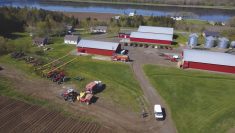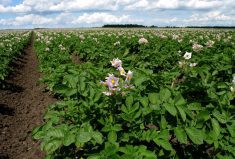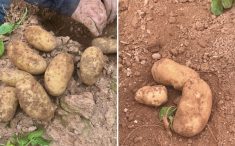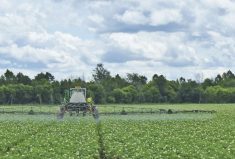This growing season, potato producers in Canada will be on the lookout for dickeya, an emerging blackleg pathogen in the U.S. that caused significant crop losses in the country’s northeastern region in 2015.
Preventing new diseases like dickeya and keeping old adversaries like late blight in check are important reasons why growers subscribe to farm biosecurity, which can be defined as a set of management practices designed to protect farm properties from the entry and spread of harmful diseases, pests and weeds.
Developed by the Canadian Food Inspection Agency, Agriculture and Agri-Food Canada, the Canadian Food Inspection Agency, the Canadian Potato Council and other industry members, the Producers Guide to the National Farm-Level Biosecurity Standard for Potato Growers was released in 2012 to help producers develop biosecurity plans for their farms.
Read Also

Agronomists share tips for evaluating new crop products and tech: Pt. 3
With new products, new production practices and new technology converging on the agriculture industry at a frenetic pace in recent…
“I think generally speaking the material that was in there really captured the majority of the practices that people were already implementing in one way or another,” says Tracy Shinners-Carnelley, director of research and quality enhancement with Manitoba’s Peak of the Market. She helped draft the guide as a member of the Potato Sector Biosecurity Advisory Group.
“By working on the initiative it was a great way to pull all the information together into one reference document,” Shinners-Carnelley says. “It also provided a tool for growers to be able to look at the level of biosecurity that they were already doing on their farm and identify some opportunities as to how they could improve or enhance that.”
Potato growers industry leaders
Shinners-Carnelley considers potato producers as the leaders in biosecurity within Canada’s ag industry, and says that’s been driven by necessity.
“We can never sit back on our heels and say we know… what diseases and pests are out there. It’s a dynamic industry and, generally speaking, the risk of pathogens and damage that they can do on a farm is always changing, whether it’s the evolution in the strains of late blight or new bacteria like dickeya that can be associated with blackleg,” she says.
Keith Kuhl, president and CEO of Manitoba’s Southern Potato and president of the Canadian Horticultural Council, was also involved in drafting the biosecurity guide.
Kuhl isn’t sure how many potato farmers have referred to the handbook since its release but he suspects it’s not a huge number. Kuhl believes more could be done by some provincial organizations to raise awareness within the industry of the guide and the importance of biosecurity planning.
Part of the challenge, he adds, is that farmers can feel overburdened at times by all the paperwork involving issues like food safety, sustainability and the environment, and they may tend to focus on plans that have shorter-term objectives as a result.
However, Kuhl believes most potato growers have some level of awareness of biosecurity and follow practices to safeguard their farms, even if they don’t have prescribed biosecurity plans in place.
He believes biosecurity is important, not only as a way to help growers protect their investment, but also to protect future generations of farmers from disease, pest and weed threats. “Part of being sustainable is having a good biosecurity plan for your farm,” Kuhl says.
This article was originally published in the 2017 issue of the National Potato Guide.















